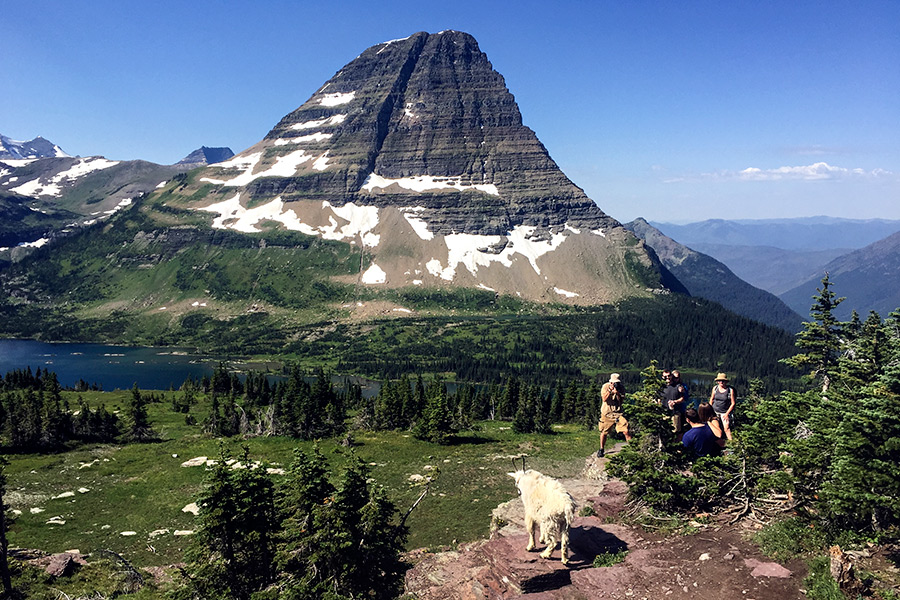As Glacier National Park enjoys an all-time high popularity among visitors, the nonprofit philanthropic organization that supports the Crown Jewel of the Continent is turning its attention to its latest priorities and support programs.
The Glacier National Park Conservancy has published its 2017 Field Guide to Park Project Priorities, a list of initiatives it hopes to support through private fundraising. The projects cover the three primary goals of the conservancy — preservation, education and research — and include short-term and long-term objectives, from installing solar panels at the North Fork Ranger Station to preserving the park’s backcountry character.
The conservancy picks its annual projects in partnership with the National Park Service and collects private donations to fund the programs and projects that the federal agency cannot necessarily tackle on its own. For example, last year the conservancy funded a new biker shuttle on the west side. Also, the group helped pay $100,000 to recreate the iconic double-helix stairway at the Many Glacier Hotel, which is under construction. Last year, the conservancy paid $30,000 to reconstruct the popular Trail of the Cedars that was built in the 1930s as a pathway that now meets Americans with Disabilities Act standards.
The latest lineup of projects includes added research on the impacts of climate change on the Glacier landscape and its wildlife, such as mountain goats. There is also a list of projects focused on enhancing sustainability in the park with new renewable energy sources and technology.
The conservancy is also in the process of hiring a new CEO, which is expected to occur in the next four months, according to the organization. Mark Preiss stepped down in June as president and CEO after three years.
For a complete list of priorities, visit www.glacier.org.
Park Project Priorities
Some of the Glacier National Park Conservancy’s 2017 priorities
Implementing Waterton-Glacier International Dark Sky Designation
This month, Waterton-Glacier International Peace Park is expected to receive its provisional designation as an official dark sky preserve, making it the first international transboundary site to be recognized. The provisional status will be removed once the two parks attain roughly 64 percent compliance with dark-sky friendly light fixtures. The conservancy hopes to replace approximately 200 non-compliant fixtures. These fixtures will promote a healthy night environment for the park’s numerous nocturnal species and provide a better visitor experience, the conservancy says. Installing lighting that will only illuminate the space below, not above, the horizon line will also improve dark sky views inside the parks.
Safe Backcountry Food Storage
The conservancy is hoping to purchase new lightweight bear-resistant food storage bags that are approved for use in grizzly bear habitat. The storage units will be available for check-out from the park’s backcountry permit office.
Providing a Glacier Park Experience to Every Student in Northwest Montana
Every student living in Northwest Montana should experience the great national park in their backyard at least once, and the conservancy is trying to make that happen. The National Park Service already partners with local schools for field trips, but the demand has reached capacity. Last year, there was a waiting list, especially on the east side of the park. The conservancy would like to expand programs and field trips for first and second graders with a wide range of subjects from wildlife to habitat. Funding would support staffing, materials and supplies for the programs, along with transportation.
Glacier Youth Conservation Corps
Each year, groups of young people ages 15-24 sign up for the Glacier Youth Corps, an organization that serves within the park on projects that include trail maintenance, monitoring of sensitive species and weed elimination. This organization is a partnership with the Montana Conservation Corps and creates a way for young people to get involved with helping the park. Funding supports the ongoing operations of this group.
Bringing Solar Power to North Fork Ranger District
The North Fork Ranger District is currently powered by a pair of propane generators that run 24 hours a day, year-round, helping park staff who live and work in the area. The remote location of the station limits how electricity can be generated, but solar power is an option. The conservancy would like to implement a sustainable power source that would decrease fuel use and noise by 66 percent by installing three pole-mounted solar arrays with 36 solar panels each, connected to a new battery that will store power.
Providing Access for All to Many Glacier’s Swiftcurrent Lake Trail
The 2.5-mile Swiftcurrent Lake Trail is a popular one in the Many Glacier Valley, but it lacks accessibility for all. This project would make more sections of trail accessible and eventually connect to the north end of Josephine Lake.
Installing Renewable Energy Technology at Logan Pass
One of the most heavily visited areas in the park, Logan Pass is in many ways the hub of Glacier Park. By improving electrical systems at the visitor center, the park will reduce sound pollution and demonstrate a commitment to sustainable energy options. The center currently gets electricity produced by combustion-driven generators. The conservancy is researching the renewable options that could replace the current system, including solar and wind power. The improved electrical system is expected to improve radio operations in the area, as well.
